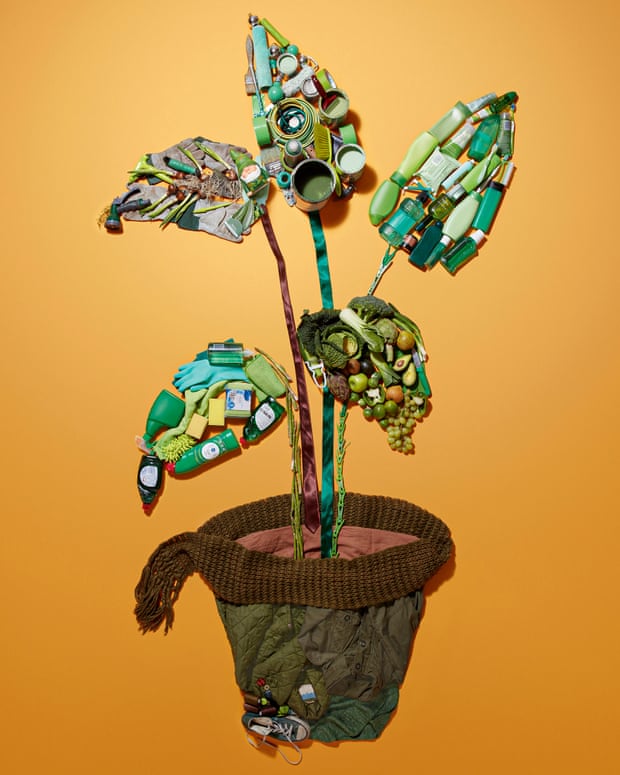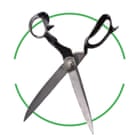Justin Wants to Use a Product That is Easy on the Environment
Clean up your kitchen
Love your leftovers
Look at what basics you're binning. "Chefs talk about what to do with carrot tops or whey from cheese, but that's not where we need to make changes," says Feast food writer Anna Jones. "It's the milk poured down the sink and stale bread – the items we don't put as much value on." Jones tears up bread to freeze for instant croutons, or whizzes it into breadcrumbs for adding to croustades, pastas and salads. If oats have already been made into porridge, follow Claire Thomson, chef and author of The Art Of The Larder (Quadrille, £25), and substitute for some of the flour and water in bread dough.
Treat "food waste" as ingredients, says Ollie Hunter, chef and author of 30 Easy Ways To Join The Food Revolution (Pavilion, £14.99). "It's easy to turn it into something else; aquafaba (chickpea water) can be made into a vegan mayonnaise; fry squash seeds in oil and sprinkle with salt for a snack; cut courgette stalks into penne shapes and cook like pasta. You need to find creative ways to use everything up; wasting food is down to a lack of imagination."
Use tech for good
Apps are taking the fight to food waste. Olio connects neighbours and local retailers so surplus food can be shared; Too Good To Go enables cafes and restaurants to sell uneaten meals at reduced rates; while Farmdrop connects you with sustainable local farmers. To recycle kitchen scraps, find neighbours with a compost bin (or chickens) at sharewaste.com.

Shop little and often
A lot of waste comes from doing big shops, putting two-for-one "bargains" in the trolley and buying on repeat rather than planning meals. "I'm always clear about what we will eat at home and when," says Skye Gyngell, chef and founder of Spring in London, which runs a "scratch menu" using waste. She shops little and often, supported by a store cupboard of wholegrains, olive oil, vinegars and mustards to bolster meals. "Working out what kind of cook you are is also useful," says Jones, "then reverse engineer how you shop. There is no point doing a weekly shop if you like to decide what you're going to make for dinner at 6pm, like me. I shop in small increments, and I find I waste less this way, too."

Buy half your food locally
The shorter the food chain, the less waste created before it reaches your kitchen. Hunter subscribes to buying 50% of food grown within 30 miles of where you live. "It's an achievable figure," he says, especially when producers, such as Hodmedod's in Suffolk, are reviving homegrown pulses including British lentils, quinoa, carlin peas and fava beans (which Hunter ferments to turn into miso and soy sauce). The nutritional value of fruit and veg lasts for only a short time, adds Gyngell, so how far your food has travelled matters.
Pick your own
"Foraging solves many problems," Hunter says. "You're getting into the countryside, engaging with nature and the community, and finding food that has a different flavour." Start with herbs, grasses, berries, wild garlic and, a favourite of Hunter's, nettles ("They're so underrated"). Use to garnish pies, in risottos and soups; wear gloves to avoid stings and wash thoroughly in salted water. Ensure foraged ingredients are identifiable before eating – check woodlandtrust.org or wildfooduk.com.
Switch your flours
Crops can't be grown every year in the same soil without replacing nutrients taken by the plants, and switching the flour you use can help. "Spelt or wheat is often grown in rotation with rye and clover to replace lost nitrogen," says Hunter. "Eating rye supports the farmers' rotation; I use spelt and emmer flour as an alternative to wheat because they have similar baking properties, while being beneficial to the soil."
Befriend a butcher
"There is no way around it, eating meat sustainably requires a little more effort on our part," says Fergus Henderson, chef and godfather of nose-to-tail eating. His first rule is to "hug" your butcher: "Support them and ask questions – they are your way in to a positive supply chain. They will also give you access to the insides and extremities, such as kidneys, shanks, feet and glands, which offer so much more possibility and flavour than the fillet." Whole-animal eating is not about blood and guts, but "respecting the animal enough to realise that, if it has died for you, the least you can do is make use of every part".
Compost on the go
Compost isn't just for the garden – think about reducing your food waste when you're on the go, too, says Lindsay Miles, whose book Less Waste, No Fuss Kitchen: Simple Steps To Shop, Cook And Eat Sustainably (Hardie Grant, £12.99) is out in June. "A reusable coffee cup makes a great impromptu container for your lunch scraps – take apple cores or bread crusts home to compost."
Plan ahead
Make the most of seasonal gluts and preserve vegetables in oils, vinegars, chutneys, ketchup and marinades, or freeze them. "Blitz and freeze tomatoes in containers for passata all year round; make kimchi from cauliflower stalks and leaves; use beetroot in jams, vinegars and oil, then chop stalks and leaves to top pastas, pizzas, curries and dal," says Hunter.
Minimise packaging
Look for loose fruit and vegetables, and take your own containers to shops and markets. "If you are buying packaged food," says Miles, "look at where the product comes from and try to choose the more local option – oat milk from Scotland will have a lower carbon footprint than almond milk from California, even if they have the same packaging." The most recyclable plastics are PET, found in drinks bottles and fruit punnets, and HDPE, in milk bottles and cereal box liners; so if you can't avoid it, go for these, then reuse or recycle what you can.
All green on the home front

Reduce your washing
Erin Rhoads' Waste Not Everyday (Hardie Grant Books, £10) points out that "the majority of the environmental burden caused by fashion happens after we take the clothing home: 82% of the energy a garment will use is in the washing and drying we do each week". Rhoads suggests spot-cleaning, and neutralising smells with a spritz of diluted vodka or lemon juice.
Clean with castile
By making cleaning products (from polish to detergent) you can reduce the amount of plastic entering your home and the level of harmful VOCs (volatile organic compounds), such as formaldehyde, that are released. "Of all the green cleaning ingredients I use, liquid castile soap is by far my favourite," writes Jen Chillingsworth in Clean Green (Quadrille, £7.55). "Originating from Spain, castile soap was traditionally made with pure olive oil, but is now more commonly produced by mixing vegetable oils such as hemp, avocado, jojoba and coconut." For a simple, multipurpose kitchen spray, add 50ml of castile soap to 800ml tap water in a spray bottle. Add a few drops of essential oils (tea tree is antibacterial). Spray and wipe with a clean cloth.

Go for plastic -free personal care
There is a world of waste-free sanitary protection to explore, and Chillingsworth suggests buying a reusable tampon applicator. "The reusable version fits every size of tampon, is antimicrobial and easy to insert. After use, give it a wipe, rinse and return to the storage box that fits in your handbag. Sterilise in hot water between periods."
Recycle as much as you can
"Most major supermarkets provide plastic recycling collection points in store for stretchy plastic (such as frozen food bags, carrier bags and bread bags) which normally can't be recycled from home," says Helen Bird, plastics expert at government waste advisory body Wrap.
TerraCycle rescues hard-to-recycle waste that is not processed by councils. It has free national recycling programmes and also sells zero-waste boxes, which you can fill with most non-hazardous, non-recyclable and non-organic waste, and return for recycling. Search its website for a scheme near you, or set one up.
Look after your electrical appliances
The Restart Project is a social enterprise that aims to fix our relationship with electricals and electronics. Cofounder Janet Gunter says the first step in keeping household appliances for longer is regular cleaning. "By simply cleaning and maintaining your white goods, laptop or mobile, you will prolong its life." Restart runs a nationwide network of skill-sharing workshops as well as promoting a directory of commercial repair options in London. (See also repaircafe.org for events in your area.) "If we don't have access to spare parts," says Gunter, "these appliances will be thrown away, which has a huge carbon impact."
If your electrical appliance really is beyond repair, Rhoads suggests you "call the manufacturer or company of purchase to see if they will take back items or packaging for reuse or recycling". Not all charity shops accept electrical items, but the homelessness charity Emmaus accepts working items. These are tested before being resold, which makes it a good place to purchase secondhand electrical goods, too.

Create clean air
"You can never have enough house plants," says Oliver Heath, who runs a sustainable architecture practice. Certain plants are best for certain rooms: "Mother-in-law's tongue gives off oxygen at night, which makes it best suited to the bedroom." According to Chillingsworth, peace lilies and boston ferns thrive in rooms with high humidity and can reduce the mould spores in the air, making them ideal for bathrooms; weeping figs have been found to be the best plant for removing formaldehyde released from carpets and furniture, making them good for living areas.
Change your shower head
"Investing in an aerated shower head will make a significant difference to energy and water consumption," says Brian Horne at the Energy Saving Trust (EST). They inject air into the water stream, limiting water usage. "A water-efficient shower head could save a four-person household £70 a year on gas for water heating, and a further £115 on water bills if they have a meter," says Horne.
Opt for green energy suppliers
There are "shades of green" when it comes to choosing an energy supplier, says Horne. The EST identified four suppliers who clearly listed the renewable sources of their energy on their websites last year: Green Energy UK, Good Energy, Ecotricity and Octopus Energy. "But just because you're on a green tariff, it doesn't mean you should stop worrying about how much energy you use," says Horne.
Practise eco-driving
Research by the RAC Foundation has found that eco-driving leads to safer, cleaner and more affordable journeys. Regular vehicle maintenance improves fuel efficiency by as much as 10%. Before a long journey, check tyre pressures (tyres underinflated by a quarter can cause a 2% increase in fuel consumption), remove unused roof racks and boxes, and don't overload the car (every additional 45kg reduces fuel economy by 2%). At less than 40mph, it's more fuel-efficient to open a window than use air conditioning. Turn off engines for waits of more than one minute (5-8% of fuel is consumed while idling), and avoid sharp acceleration and heavy braking: aggressive driving can significantly raise fuel consumption.
Draught-proof your home
One of the cheapest, most effective ways to save energy and money at home is to draught-proof windows, doors, letterbox, fireplaces and loft hatches, says Dr Sarah Price, head of building physics at Enhabit, a consultancy specialising in low-energy design. Done professionally, it costs about £200, or do it yourself with products such as Gap Seal.

Buy vintage furniture
"Reusing furniture is the best thing to do, and so much more fun than buying new," says Nicola Harding, founder of interior design studio Harding and Read. "Secondhand items come with interesting stories and force you to think creatively, and give you have something far more unique." To keep mileage down, start at your local auction houses and charity shops (the British Heart Foundation has dedicated home stores and a free collection service), followed by a targeted trawl through Freecycle and Facebook Marketplace.
Optimise your white goods
According to independent energy comparison service U Switch, the cost of running your fridge and freezer equates to about 7% of your total energy bill (they are one of the few household energy devices that are on all the time). U Switch recommends replacing your fridge and/or freezer if it is over 10 years old. Even if it's working, the cost of a new model will be made up for in energy savings over the years. Keep your fridge at 5C or less (most are kept at about 7C, which means food will go off sooner) and ensure there is a 10cm gap behind your fridge to let heat flow away easily. Make sure the seal is strong – if it can't hold a piece of paper when shut, it could be letting in warm air, making it work harder.
Let the garden grow


Buy local flowers – or grow your own
About 90% of the flowers sold through UK florists, supermarkets and wholesalers are imported, mainly from the Netherlands, but they are also flown in from countries as far away as Ecuador, Colombia, Kenya and Ethiopia. Reduce your floral air miles and find a local supplier through flowersfromthefarm.co.uk, a co-operative of small independent flower growers.
Alternatively, grow your own flowers to bring indoors. Gardener Sarah Raven suggests going for "annuals which are cut and come again: pick above a pair of leaves and the plant will spring back and produce more flowers – and keep on doing so as long as you keep picking". Sow cosmos, snapdragons, zinnias and rudbeckias on a sunny window ledge in March, pot on and plant out after the last frosts.

Encourage bees
Honeybees visit only one type of flower in any one foraging trip, says Sarah Wyndham Lewis, author of Planting For Honeybees: The Grower's Guide To Creating A Buzz. "This is called 'flower fidelity' and is what makes them such effective pollinators. So plant large clumps or 'drifts' of single species and optimise each of the bees' trips." Think swathes of catmint, field scabious and hyssop. "March to September are the key months for honeybees – they will fly whenever the temperature is above 10C, even in winter, so early- and late-flowering plants are especially valuable," she says.
Spend less, prop agate more
Your own plot is the best garden centre there is: collect seed, learn to take cuttings and divide plants to stock your own backup nursery. Gaps can then be filled with home‑propagated stock plants. Increase what does well in your garden to build a healthy community of plants. If you do go shopping, research a plant's natural habitat to reduce failures.
Lock up carbon
In The Garden Jungle, Or Gardening To Save The Planet (out in paperback 2 April, Vintage, £9.99), Dave Goulson explains that although many gardeners don't have room for large trees, "The basic rule is that the more vegetation you have, the more carbon you are storing." So the fuller the planting in your garden, the better, even if it verges on overgrown. Don't be too tidy, either. "Log piles also lock up carbon for as long as it takes them to decay, which can be many years."

Let the grass grow
Letting your grass grow longer between cuts not only saves petrol or electricity, and therefore reduces carbon dioxide emissions, but also encourages more wildlife into your garden. Longer grass is more drought-resistant, too. Try cutting every three or four weeks and let dandelions, daisies and violets bloom in spring, followed by buttercups, clovers and selfheal in summer.
Encourage hedgehogs
Hedgehogs have a voracious appetite for pests such as caterpillars, slugs and snails. They need easy access in and out of gardens, say Helen Bostock and Sophie Collins, authors of How Can I Help Hedgehogs? (Octopus, £14.99). They recommend that neighbours get together to arrange hedgehog holes between gardens. "This is simply a hole cut into the bottom of a fence – it should be around 13cm high and at least as wide, preferably in a sheltered corner."
Reboot your wardrobe
Set a bar
If a year without buying anything new seems too big a challenge, try a month, or buy only secondhand. Livia Firth, founder of sustainability consultancy Eco-Age, follows the "30 wears rule": ask, "Will I wear it at least 30 times?" before buying.
Find a secondhand that works for you
Opting for vintage or secondhand is one of the easiest ways to shop sustainably, but while some fans will extol the virtues of rifling through giant warehouses, this approach is not for everyone. Thankfully, there are other ways. Smaller stores with a curated selection may not offer quite the same bargains as a car boot sale, but they can be less intimidating. Many, such as Paper Dress Vintage or Cow, also have websites.

Shop in person – and alone
That said, shopping in person – especially if you walk there – is usually greener than online. Clothes shipped across the world have a significant carbon footprint, and often come packaged in plastic. You are also less likely to return things you have tried on.
It can help to ditch your friends. "When you ask a friend if you should buy something, you already know the answer will be yes," writes Lauren Bravo in How To Break Up With Fast Fashion (Headline, £12.99). "It's an unwritten rule of sisterhood." Think of it as the new version of not going supermarket shopping when you're hungry.

Choose materials wisely
Some fabrics age better than others; the Guardian's styling editor, Melanie Wilkinson, recommends looking for leather when shopping secondhand. Leather jackets, shoes and belts last for years and often look and feel better once they have been worn in. The environmental impact of denim – another durable fabric – means jeans are also best bought secondhand.
Unsubscribe and unfollow
"If someone wants to quit fast fashion, I recommend unsubscribing from all the emails," says writer and fashion consultant Aja Barber. "A brand that is constantly introducing new products might be sustainable in name only. Sending emails and pressuring consumers to buy, buy, buy is not sustainability – that's fast fashion." The same goes for influencers and brands on social platforms such as Instagram. Deleting fast-fashion shopping apps can help, too.
Get swishing
Clothes swaps – known as swishing – are one of the greenest ways to refresh your wardrobe. They offer credits based on the value of the items you bring, which can be swapped for items brought by others. Avoid trends and hunt for quality pieces you'll wear for years. Find one near you at swishing.com.
Learn to mend

Make your clothes fit
Layla Sargent, founder of The Seam, a website to connect you with local tailors, seamstresses and embroidery artists, says: "If it doesn't fit well, you're never going to wear it. Even by making trousers just the right length, or altering a waistband slightly, we will be inclined to wear them more." The service is currently only in the London area, but coming to Manchester and Birmingham this year. Meanwhile, start with your local dry cleaner.
Learn how to sew on a button
How many shirts and jackets do you keep unworn at the back of your wardrobe because they are missing a button? Sewing on a button is a simple skill that everyone should have. There are lots of online tutorials; try one by the environmental activist Wilson Oryema for Fashion Revolution.
Make your own apron from a pair of old jeans
Turn a pair of old jeans into a denim work apron by unpicking the inside leg seams and stitching them together. This is one of many hacks from The Great British Sewing Bee's book on Sustainable Style (Quadrille, £27, published on 26 March).
Darn your socks
"Once a life skill, darning has skipped a generation (or two)," says Emma Mathews of Socko (socko.shop), which makes socks from repurposed yarn. "But we can learn a lot from the way things were done in the past." Sew small running stitches up and down the area around the hole and then turn the repair around and stitch perpendicular to them, weaving the thread together until you have covered the hole. Highly therapeutic.
Primp your trainers
This is a growing service industry. Gråel in Liverpool is a small business that specialises in cleaning "coveted footwear", offering laces cleaning (£3), a deep clean (£15) and the meticulous premium package from undersole to insole (£35). Meanwhile, Jason Markk offers premium shoe care from branches in LA and Carnaby Street in London, where your trainers will be brought back to life by the brand's sneaker-care technicians.
Give the bathroom a makeover

Recycle in there
While 90% of us recycle our kitchen waste, we recycle only 50% of our beauty packaging – probably because our recycling bins are in the kitchen. Joseph Joseph makes an attractive split-waste bathroom bin for £20. You can reduce what ends up inside further by switching to bar soaps and shampoos (I love social enterprise Beco, from £2.50 at Co-op, Boots and supermarkets) and plastic-free handwash such as Soap Co (£19, 300ml, or £110 for a whopping 5l biodegradable container that should last a year).

Lose the disposables
A staggering 20,000 litres of water are needed to create only 1kg of cotton – that's enough to make just one T-shirt and a pair of jeans, so any cotton you buy should count. Replacing cotton wool is a good start. Remove the initial bulk of makeup with a reusable disc, such as Face Halo (£7), soaked in plain water. These do an astoundingly good job, even on waterproof mascara. Follow with a cleanser and a wet terry-cotton flannel; both flannel and disc should last for hundreds of washing machine cycles. For toners, exfoliants and nail polish remover, use washable bamboo pads. A pack of 18, plus washbag, costs about £10.
Pick the right package
There's no justifiable excuse for packaging short-use, everyday beauty products in virgin plastic. There are now a large number of brands packaging in post-consumer recycled plastic (PCR), from the luxury (Aveda, REN, Biolage) to the mid-range (Soaper Duper, Lush), to the mass (all Simple and Dove bottles are now 100% PCR in Europe; L'Oréal Elvive, the world's bestselling haircare brand, is rolling out 100% PCR bottles this summer – the caps are recyclable but not made from PCR – saving 7,000 tonnes of plastic globally a year). Alternatively, you could opt for products packaged in glass that haven't travelled too far. Neal's Yard mostly uses glass where safe, and distributes from Dorset.
Don't be tempted by minis
Those pick'n'mix bars of travel-sized beauty products are so alluring, but cause a huge amount of waste for no reason and very little product. Instead, make a one-off investment in refillable travel bottles and pots from Muji (from 95p) or any high street chemist, and decant your favourite full sizes – or, even better, wash out and reuse any mini bottles you already have. Remember that active skincare such as vitamin C or retinol serums are best left in their original packaging to safeguard their stability, but anything else can be decanted for travel. And if you have so many minis left over from flights and hotel stays that you won't use them all, take them to your nearest homeless shelter, where their clients need them.

Embrace baths
Baths have long been seen as more wasteful and less responsible than showering, but some research shows that modern, pumped power showers can use more, not less, water than bathing. It is possible to enjoy a luxurious, but environmentally considerate, bath. Use sulphate-free oils, salts or foams and relax (I've even been known to wash posh, delicate bras while I soak). You can save more water by washing hair over the bath before climbing in, allowing the water to fill the tub – the shampoo will create bubbles, too.
Save to save the planet
Save water and lower your bills
Consider switching to a water meter, so you pay for only the water you use. Invest the money you save into water-saving devices and plumbing, such as rainwater harvesting and greywater recycling systems. Get free water-saving products from savewatersavemoney.co.uk. If you live in England and Wales, you can get a water meter fitted for free, but you may need to pay £300 if you live in Scotland. A number of investment funds have clean water and sanitation as their dominant theme, says Becky O'Connor of Royal London. For example, Parvest Aqua and RobecoSam Sustainable Water are recommended by ethical financial website good-with-money.com.

Get a loan to improve your home's energy efficiency
Some lenders provide cheap green mortgages and loans for energy-efficient improvements. Ecology Building Society offers discounts to customers borrowing for this. Nationwide says it will start offering low-interest loans of up to £25,000 to homeowners who want to retrofit existing properties with energy-efficiency measures.
Choose an environmentally friendly current account
Nearly £150bn has been invested in fossil fuels by UK banks since the Paris climate agreement was adopted in 2016. Ethical bank Triodos, which has the backing of Friends of the Earth, invests only in projects that create positive cultural, social and environmental outcomes. To review your bank's track record, see lobbying organisation BankTrack, which reports on the activities that banks finance worldwide.

Invest wisely
"Look at funds with sustainability in mind," says Alice Evans, co-head of the BMO Global Investment's responsible investment team. "Invest in funds that are described as 'responsible', 'SRI' (socially responsible investment), 'ethical' or 'dark green'. These have the strictest criteria and avoid investing in any company that may have a poor record on environmental, human rights or other ethical grounds."
Evaluate your pension
"For many people, their workplace pension will be their largest investment," says Rich Mayor of research and analysis company Fundscape. You have the right to know where your money is being invested. "Ask your HR department or pension provider what funds you're invested in and whether there is a sustainable or ethical option," says Jon Dean, head of retirement strategy for financial services consultancy Altus.

Get a green financial adviser
Last year, a new financial advice firm called The Path was set up to invest only in portfolios that have a positive impact on the planet. "You don't need to be a millionaire to invest your money wisely," says founder David MacDonald. "With very little effort you can make a significant difference, moving from harming the planet with your money to sustaining it." Some research suggests that making sure your investments are sustainable has 27 times more impact than all the other things you could do to reduce your carbon footprint added together. "If you put the maximum annual ISA contribution of £20,000 into a positive-impact fund, it would be the carbon equivalent of taking one car off the road," MacDonald says.
Source: https://www.theguardian.com/environment/2020/feb/29/50-ways-to-green-up-your-life-save-the-planet
0 Response to "Justin Wants to Use a Product That is Easy on the Environment"
Post a Comment